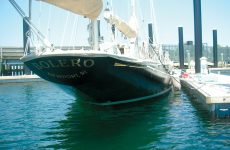
The Ticonderoga undergoing her first significant refit in 30 years. Photo by David Stewart
October 2021
By Capt. Michael L. Martel
Good men do not let good boats die.
This thought, like an ancient proverb, came to me and stuck in my head following a recent conversation with Captain Guillaume Touhadian, Captain of the classic L. Francis Herreshoff sailing yacht Ticonderoga. Captain Guillaume had been inaccessible for a few days while he and his crew worked feverishly on a comprehensive refit of the 1936 72-foot, clipper-bowed ketch. He’d had no time to talk, then, but now he could. Ticonderoga was in the water again at a dock in the Taunton River, Mass., and he admitted that he could finally step back and look at her with deep satisfaction and pride. She had not looked like this in quite some time and the reality of it caused him to draw in a deep breath and to quietly appreciate how far she had come. She has been his charge now for some six years all told.
Good men do not let great boats die; indeed, good men become caretakers instead. Ticonderoga is restored and beautiful, once more, and the great road that is built over the waters of this world will once again take her to her winter’s playground in St. Bart’s, around the classic yacht racing circuit, and then back up to her summer home in Greenwich, Conn., as her cycle of passage takes her every year.
A legendary classic sailboat designed by L. Francis Herreshoff for the intrepid yachtsman Harry Noyes, the 72-foot, clipper-bowed ketch was originally named Tioga II. Her second owner bought the boat, but not the name, and while doodling with pencil emblazoned with the brand name Ticonderoga, he saw the answer that kept intact both the letters and the intent of her original name. Over the decades there have been several owners, each with a story all their own. Tioga was initially conceived as a family day sailer.
Designed in a year, building began in 1936 at the Quincy Adams Yacht Yard in Massachusetts. Tioga of Marblehead was designed with performance in mind. Harry Noyes, a man of means, owned larger vessels for cruising purposes, and meter boats to satisfy his racing whims.
Currently, she is owned by L. Scott Frantz, of Greenwich, Conn. “He’s been very dedicated to the boat,” Guillaume says, “You know, he’s 61 and he’s owned the boat since he was 32 years old.”
Her last major refit was 30 years ago in the U.K. Since then, everything about her has aged, of course, so this refit, overseen by Guillaume, has focused primarily on systems replacement and upgrades, from engine to electronics to wood.
Ti has been repowered; her tired, late `60s rebuilt Detroit diesel engine has been replaced with a more environmentally-friendly power plant. The refit was interrupted for nearly a year by the pandemic and restricted travel.
Her high-quality old Burmese teak deck was found to be in great shape, so it was heavily refinished. New sails were bent on only days ago (mid-September).
Electrolysis issues and “currents running everywhere” in the hull caused some delignification issues that had to be addressed with wood replacement and corrections to the electrical and grounding systems, all made somewhat more difficult by the fact that Ti is double-planked. A new generator, single 12V system and new LED lighting, plus new Garmin electronics for navigation round out the improvements. Many upgrades were designed to support a lower electrical power demand goal.
A new up to date air-cooled refrigeration system allowed the elimination of some through-hulls that weren’t needed anymore. As any boat owner knows, fewer holes in the hull is always a good thing.
“One major thing we did, which was mandatory after so much work inside, was to completely repaint and re-varnish every square inch down below,” Guillaume says. “And that took a crew of seven guys from Antigua close to 12 to 14 weeks, working six days per week.” He found them temporary living accommodations a few miles away in Fall River, and they worked non-stop. Some of them, Guillaume says, have been involved with the boat for almost three decades. The yard, Bristol Marine, didn’t object. “They were working under my guidance, and are considered crew, so accommodating that arrangement was a nice gesture by Bristol Marine,” Guillaume says.
She’s rigged, the bunks have new sheets and mattresses, the new stewardess has made the beds for the first time, Guillaume says, and the new cook is aboard. There is some rig tuning to do and small tweaks and adjustments, part of the endless cycle. Next, Ti heads for Greenwich, and eventually she will make her way to Nelson’s Dockyard, in English Harbour, Antigua, before heading to Gustavia, St. Bart’s, where her next big event will be participation in the Antigua Classic Yacht Regatta at the end of March. Then she will head north once again for Greenwich and summer in New England.










